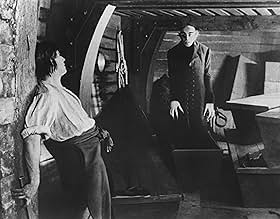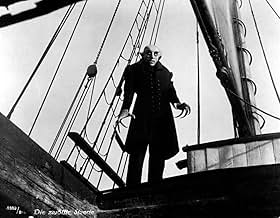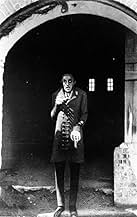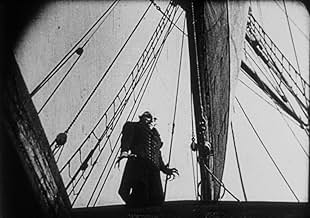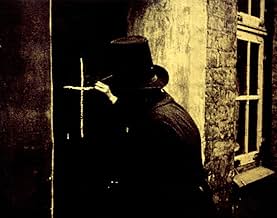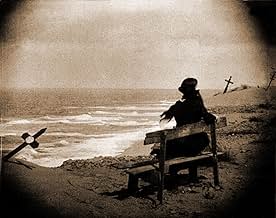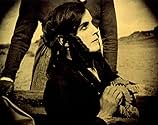Le comte vampire Orlok exprime son intérêt pour une nouvelle résidence et l'épouse de l'agent immobilier Hutter.Le comte vampire Orlok exprime son intérêt pour une nouvelle résidence et l'épouse de l'agent immobilier Hutter.Le comte vampire Orlok exprime son intérêt pour une nouvelle résidence et l'épouse de l'agent immobilier Hutter.
- Director
- Writers
- Stars
- Prix
- 3 victoires et 2 nominations au total
Gustav von Wangenheim
- Hutter
- (as Gustav v. Wangenheim)
Greta Schröder
- Ellen - seine Frau
- (as Greta Schroeder)
Georg H. Schnell
- Harding - ein Reeder
- (as G.H. Schnell)
Karl Etlinger
- Kontrolleur am Kai
- (uncredited)
Hans Lanser-Ludolff
- A magistrate
- (uncredited)
Loni Nest
- Child at Window
- (uncredited)
Fritz Rasp
- Knocks Mitarbeiter
- (uncredited)
Josef Sareny
- Head Coachman
- (uncredited)
Fanny Schreck
- Krankenschwester im Hospital
- (uncredited)
Eric van Viele
- Matrose 2
- (uncredited)
Avis en vedette
I despise most vampire stories. Not even Florence Stoker's dear departed husband could keep me occupied after the first act in Transylvania in "Dracula". The vampire has been so romanticized as an archetype (particularly during the '90s) that I can't but feel that most horror fans have forgotten exactly what made us afraid of these guys to begin with. Murnau's "Nosferatu" is just such a reminder and, because of that, is the only screen version of "Dracula" that I have ever loved.
Though Murnau, in the hopes of dodging the copyright bullet, took many liberties with the novel, he actually shot a great part of the film on location (an unusual practice for the time) in the historical Dracula's old stomping grounds: the Carpathian Mountains in Romania. The town, landscapes, and castles were all for real, not just some fancy studio backdrop. To me, it helps convey the tone of authenticity, as you can believe this story being told. As for Max Schreck, no charming, suave seducer is he. With his bald head, bushy eyebrows, rat-like teeth, pointed ears, nails as long as the fingers they are attached to, emaciated build, and stare that seems to come from the bottom of Hell itself, he is the primal, archetypal image of the vampire of legend.
While some could interpret this tale as a subtext to Nazism or anti-Semetism, at it's core, it's simply the tale of a monster, who brings ruin and death in his wake. That such a tale has managed to survive it's era, considering the obstacles that could have totally removed it from view, is the gain of all who have seen. Eat your heart out, Bela Lugosi.
Though Murnau, in the hopes of dodging the copyright bullet, took many liberties with the novel, he actually shot a great part of the film on location (an unusual practice for the time) in the historical Dracula's old stomping grounds: the Carpathian Mountains in Romania. The town, landscapes, and castles were all for real, not just some fancy studio backdrop. To me, it helps convey the tone of authenticity, as you can believe this story being told. As for Max Schreck, no charming, suave seducer is he. With his bald head, bushy eyebrows, rat-like teeth, pointed ears, nails as long as the fingers they are attached to, emaciated build, and stare that seems to come from the bottom of Hell itself, he is the primal, archetypal image of the vampire of legend.
While some could interpret this tale as a subtext to Nazism or anti-Semetism, at it's core, it's simply the tale of a monster, who brings ruin and death in his wake. That such a tale has managed to survive it's era, considering the obstacles that could have totally removed it from view, is the gain of all who have seen. Eat your heart out, Bela Lugosi.
10jhclues
In 1921, director F.W. Murnau set out to make a horror film based on Bram Stoker's novel, `Dracula,' but was denied the rights to the property by Stoker's estate. Undeterred, however, Murnau merely changed the title to `Nosferatu,' the name of the title character to `Count Orlok,' then proceeded to make what has come to be considered nothing less than a classic of the silent film era. An unsettling film (especially for the times in which it was made), it is a faithful adaptation of Stoker's story, and brings images to the screen, the likes of which at the time, had never before been seen. And although by today's standards much of it may seem relatively tame, there is an innate sense of the sinister about it that is timeless. For the same elements that so unnerved audiences in 1922 when it was released, are equally discomfiting now, most of which is courtesy of Max Schreck, who portrayed Count Orlok. It was the first screen appearance for what is now the most famous vampire in history, and the German character actor Schreck brought an eerie presence to the role that has never been equaled. Bela Lugosi may be considered the definitive Dracula-- his portrayal is certainly the most well known-- but even he could not match the sense of evil that Schreck brought to the character. The scene in which Schreck's shadow is cast on the wall as he slowly negotiates a staircase, emphasizing his misshapen head and elongated fingers and nails, is an image that leaves an indelible impression on the memory, as does Schreck's overall appearance: Lanky, though slightly stooped, with oversized, pointed ears and haunted, sunken eyes. It was Schreck's greatest screen role, and had it not been for a lawsuit by Stoker's estate that prevented wide distribution of the film, it would no doubt have made him a star. The supporting cast includes John gottowt, Alexander Granach, Wolfgang Heinz, Max Nemetz, Gustav von Wangenheim, Ruth Landshoff and Greta Schroder. An air of mystery surrounded the set during the filming of `Nosferatu' that became something of a myth, which began with the fact that Schreck, a method actor, was never seen by cast nor crew without his makeup and in character. And it was further perpetuated when it may have been implied by Murnau that Schreck was actually a vampire playing an actor playing a vampire, all of which goes a long way toward proving that `hype' is nothing new to the entertainment industry. One of the three most highly regarded German directors of the times, Murnau, whose philosophy was that `nothing existed beyond the frame,' directed a number of films, but none achieved the lasting notoriety of `Nosferatu.' For film buffs everywhere, as well as aficionados of silent pictures, this film is a must-see, and a perfect companion piece to the recently released (2000) `Shadow of the Vampire,' the film by E. Elias Merhige that chronicles the making of `Nosferatu.' A comparatively short film-- the restored DVD version runs 81 minutes, the video, 63 minutes-- it will nevertheless provide an entertaining and memorable cinematic experience. This is an example of not only the magic, but the magic at the very core of the movies. I rate this one 10/10.
For copyright reasons, Bram Stoker's novel was filmed with the names of the characters changed (Orlok for Dracula, for example) but otherwise the story remains the same: a young man goes on a trip to see a mysterious count in order to sell a house, leaving his bride behind, and finds that the creature he meets is not of this world.
As the extremely creepy Orlok, Max Schreck is brilliant, with his long fingernails and gaunt appearance. A triumph in early cinematic make-up. Gustav von Wangenheim portrays the confusion of the victim well, as does Greta Schroder as his wife. FW Murnau directed the film with flair, showing us not only shadowed vistas and abandoned castles, but the nature outside (foxes) and miniature worlds evolving under a microscope. This film sits well with his later 'Sunrise' in showing the effect of outside forces on a young couple, as well as being one of the key early horrors in its portrayal of Stoker's anti-hero.
This version of the Dracula tale remains one of the best, although all have some different perspective on the novel. On the strength of 'Nosferatu' alone, Murnau deserves his place as a true innovator of silent cinema.
As the extremely creepy Orlok, Max Schreck is brilliant, with his long fingernails and gaunt appearance. A triumph in early cinematic make-up. Gustav von Wangenheim portrays the confusion of the victim well, as does Greta Schroder as his wife. FW Murnau directed the film with flair, showing us not only shadowed vistas and abandoned castles, but the nature outside (foxes) and miniature worlds evolving under a microscope. This film sits well with his later 'Sunrise' in showing the effect of outside forces on a young couple, as well as being one of the key early horrors in its portrayal of Stoker's anti-hero.
This version of the Dracula tale remains one of the best, although all have some different perspective on the novel. On the strength of 'Nosferatu' alone, Murnau deserves his place as a true innovator of silent cinema.
F.W. Murnau directs this unauthorized version of Bram Stoker's novel, Dracula. NOSFERATU is arguably the earliest surviving screen version depicting the 'Prince of Darkness'. This German production deviates slightly from the original, but the now familiar story we all know by heart is intact. Count Dracula becomes Count Orlok and journeys to Bremen, Germany instead of London. His physical appearance is not dashing, mesmerizing or even mystical; but much resembles the rats that frequently accompany him. I find this the most eerie of all that would follow. The accompanying organ music background makes this scratchy black and white silent film an essential masterpiece. Max Schreck is immortal as Nosferatu/Count Orlok.
F.W. Murnau set the bar high for vampire movies, very high. Can not help but start praising the job Max Schreck and Murnau did to bring Count Orlok character to life on the screen. Orlok's face, hands and slender build along with his sly shuffling movements with the right camera angles and props brought a hell of a lot of general creepiness. The viewers in the twenties must have been shell shocked because they didn't tame it down which they most often did in this time period. For a full length silent feature film I found the time going fairly fast with a view dragged out scenes, that can be expected. The big bugaboo I have with Nosferatu though is the questionable ending being terribly anticlimactic. Regardless of the disappointing ending, Nosferatu is a killer film that is a must watch for horror or classic movie fans.
Le saviez-vous
- AnecdotesThe movie was banned in Sweden due to excessive horror. The ban was finally lifted in 1972.
- Gaffes(at around 30 mins) When Hutter is writing his letter to Ellen in Count Orlok's castle, the paper that he is meant to be writing on is clearly blank throughout the scene.
- Citations
Graf Orlok: Your wife has such a beautiful neck...
- Autres versionsThere are a confusing number of different surviving prints, restorations and alternate versions of Nosferatu. In the main, there are three 'complete' restorations and two incomplete, partially-restored versions. All five are available on DVD, while the latest two restorations, from 1995 and 2006, are also on Blu-ray. In addition there are countless low-quality public domain DVDs with different lengths, running speeds and soundtracks. All are derived from a single print held by the Museum of Modern Art (MoMA). They usually have replacement American intertitles and are always in black and white; the film was originally color tinted throughout and only meant to be seen that way. This comprehensive article explains all of them simply and clearly: Nosferatu: The Ultimate Blu-ray and DVD Guide.
- ConnexionsEdited into Boo (1932)
- Bandes originalesJeux d'enfants - Galop
Written by Jack Norworth
[Plays during the croquet scene in the 2006 restoration]
Meilleurs choix
Connectez-vous pour évaluer et surveiller les recommandations personnalisées
- How long is Nosferatu: A Symphony of Horror?Propulsé par Alexa
- How many different versions exist of 'Nosferatu'?
Détails
- Date de sortie
- Pays d’origine
- Site officiel
- Langues
- Aussi connu sous le nom de
- Nosferatu: A Symphony of Horror
- Lieux de tournage
- Starhrad Castle, Nezbudská Lúcka, Slovakia(castle in ruins)
- sociétés de production
- Consultez plus de crédits d'entreprise sur IMDbPro
Box-office
- Brut – à l'échelle mondiale
- 48 892 $ US
- Durée1 heure 34 minutes
- Mixage
- Rapport de forme
- 1.33 : 1
Contribuer à cette page
Suggérer une modification ou ajouter du contenu manquant

Lacune principale
What is the Japanese language plot outline for Nosferatu le vampire (1922)?
Répondre

